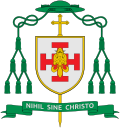| St Paul's Church | |
|---|---|
 | |
 | |
| 53°27′22″N2°04′13″W / 53.4562°N 2.0702°W | |
| OS grid reference | SJ 95432 95491 |
| Location | Hyde |
| Country | England |
| Denomination | Roman Catholic |
| Website | StMaryandStPaul.org |
| History | |
| Status | Active |
| Founded | 1848 |
| Dedication | Paul the Apostle |
| Consecrated | 1954 |
| Architecture | |
| Functional status | Parish church |
| Heritage designation | Grade II listed |
| Designated | 21 August 2013 [1] |
| Architect(s) | Hadfield, Weightman & Goldie |
| Style | Gothic Revival |
| Groundbreaking | 20 May 1853 |
| Completed | 21 June 1854 |
| Construction cost | £1,560 |
| Administration | |
| Province | Birmingham |
| Diocese | Shrewsbury |
| Deanery | Stockport & Tameside |
| Parish | St Mary and St Paul [2] |
St Paul's Church is a Catholic parish church in Hyde, Tameside, Greater Manchester, England. It was built from 1853 to 1854 and designed by Matthew Ellison Hadfield, John Grey Weightman and George Goldie. Architecturally, it is in the Gothic Revival style. It is located on Newman Street, close to the west of Newton for Hyde railway station. In 2013, it was designated a Grade II listed building. [3]

